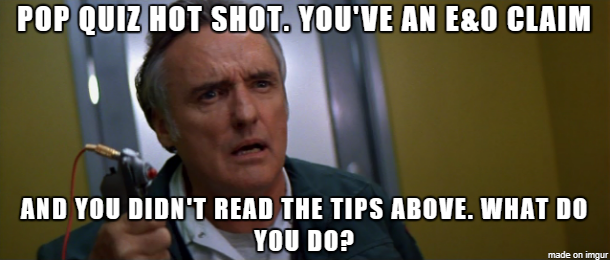
You’re probably wondering why Lead Heroes is doing a blog post about E&O coverage, or how this post might help you close more leads? Actually, we wanted to cover errors and omissions insurance because:
- We covered this topic in our book as an item that new agents need to take care of before you can start closing leads.
- E&O insurance usually renews in the month of October for most agents, which is quickly approaching.
- Not all E&O policies are priced the same, or have the same definitions or coverages, so we wanted to inform you about this necessary coverage that many agents don’t pay attention to…until it’s too late.
We hope to make this the most interesting article you’ll ever read about E&O, as we know it can be a fairly dry subject to ruminate on. So, without further ado – let’s find out:
- What exactly is errors and omissions insurance and why do you need it?
- What should you know about E&O before buying a policy?
- Who offers the most competitive E&O coverage for insurance agents?
- Who covers agents that have had prior felonies or bankruptcies?
Who knows – maybe we can save you some money on your E&O that you can put toward better things, like maybe buying more leads. Unless you’re using one of our top picks from this review article, you’re overpaying for your E&O insurance.
What Exactly is E&O?
Errors and omissions insurance protects professionals (like lawyers, accountants, engineers, consultants and agents) from any actions that might make them liable against claims of negligence or failing to perform their duties. Within the insurance industry, it’s basically insurance for insurance agents. It’s the policy that protects your ASS-ets from lawsuits if you’re ever accused of professional misconduct.
What Does E&O Cover?

Does E&O cover you against slip-and-fall accidents in your office? Nope, that’s general liability insurance, not professional liability insurance. So what does this kind of policy cover?
Here’s a list of things your E&O policy might cover, besides those listed in the picture above:
- Mistakes
- Bad Advice or Recommendations
- Defense Attorney Costs
- Claims Against You for Slander or Libel
- Employees Who Work for You
- Damages Awarded to Plaintiff
The largest thing your policy doesn’t cover is acts that are deemed willfully deceitful or fraudulent. In other words, your E&O doesn’t cover white-collar crime. Just like your auto insurance won’t cover you if you drive drunk and run into (or over) someone; your liability insurance won’t cover wanton or illegal behavior if your actions lead to a financial wreck for one of your clients.
One common misstep that many agents make that isn’t covered under E&O is failing to get advertising materials approved. Falling out of compliance with your ads because you didn’t get the insurance company to sign off on your marketing materials could possibly open you up to a future false advertising claim – which isn’t usually covered by E&O.
Why Some Companies Offer E&O for Free
Sometimes you’ll find companies that sponsor E&O coverage for their products, at no charge to the agent. Sometimes there’s a specific reason why they only sponsor E&O for their products – and that can be because the company has sub-par financial ratings and may seem risky to traditional E&O companies.
The majority of E&O companies won’t cover an agent who sells products from companies that have a financial stability rating by the major credit rating agencies (like S&P, Moody’s, and Fitch Group) lower than an A- although some go as low as a B+ rating. But beware: the sub-par companies aren’t always going to offer coverage, depending on their niche and rating. In fact, finding a sub-par company that offers its own coverage is so rare that agents shouldn’t even be looking for this feature.
However, we think it’s worth mentioning because we commonly see agents on the forums worrying that recommending anything less than an A+ company could come back to bite them. In reality, agents selling senior insurance products probably won’t ever deal with the repercussions of a company collapsing because this niche already has several safety nets in place.
Some agents reading this might wonder if the B+ rated Medicare Supplement company they sold to a lead can get them in hot water. Truthfully, the chances that you’ll receive a complaint from a senior because their Medicare Supplement company melted down is slimmer than the chances of Kanye West becoming president.
When it comes to Medicare Supplement companies, beneficiaries enrolled in a plan are allowed a Guaranteed Issued period to choose another supplement company. Here’s the CMS rule:
You’re in a Medicare Supplement Plan, and your plan is leaving Medicare or stops giving care in your area, or you move out of the plan’s service area.
You have the right to buy Medigap Plan A, B, C, F, K, or L that’s sold by any insurance company in your state.
Where this gets sticky is if the client was recently on a Plan G or N that isn’t covered under Guaranteed Issue rights. This may cause the client to go with a plan that has too many out-of-pocket costs (like Plan A, B, C, K, or L) or a plan that has too high of a monthly premium (F).
When it comes to Final Expense, the chances are even slimmer – almost nonexistent – that your clients will be left without coverage if a company shutters. That’s because life insurance contracts are usually covered by larger reinsurance pools up to a 6-figure amount – usually around $350,000-500,000 per policy, depending on the state. Seeing as how Final Expense policies are usually 4 to 5 digits, there’s practically no chance of someone losing their policy if a sub-par rated company collapses.
Do All Companies Require E&O Insurance?
Not all insurance companies require agents to hold an E&O policy – particularly, the companies that offer insurance to seniors. Why don’t they require it? We can’t say for sure, but we suspect it’s because of the reasons above: there’s usually very little risk in selling these types of insurance, anyway.
Here’s a list of insurance companies that don’t require E&O to sell their products, which could be helpful for agents who are having a tough time finding affordable E&O insurance for some of the reasons we discussed above.
- Royal Neighbors of America
- Settlers Life
- United Home Life
- Oxford Life
- Security National Life
Agents should double-check this list to make sure these companies haven’t changed their stance of E&O since our research. If you know of any other companies that don’t require E&O, leave a comment for us in the comment section below.
How Much Does Errors and Omissions Insurance Cost?
The cost of E&O depends what types of insurance you sell. With P&C, it might even matter how long you’ve been in business, as well. Errors and omissions insurance seems to be more expensive for P&C agents, but also harder to qualify for.
The most common pricing options we see between companies are grouped into three overall packages:
- Life and Health (L&H)
- Property and Casualty (P&C)
- Registered Investment Advisor (RIA)
Some of these packages have additional upsells depending whether you offer annuities, disability insurance or mutual funds. Overall, these packages range from $380 to thousands of dollars, depending on these factors. The majority of agents reading this blog are likely paying around $450-$500 per year, when they should be paying $70-$120 less.
What Should I Know Before Buying E&O?
Before selecting an errors and omissions policy, take the time to examine and understand exactly what the policy covers and what it doesn’t cover. Unfortunately, as I’m sure you’re aware, not all policies are created equal. It’s up to the agent to examine each company’s policy specimen, or policy sample, to see what is and isn’t included at what price.
For example, some companies may offer a benefit like “first-dollar defense,” which means the agent only has to cover his deductible if he’s found guilty and the claimant was awarded punitive damages, while others might not cover acts that happened prior to the policy’s effective date. Sometimes benefits are offered as riders, like follow-up coverage, called extended-reporting coverage, after retiring or separating from the insurance industry.
Here are 9 types of benefits or clauses that agents should at least be aware of when shopping for an E&O policy. Also, be aware that some of these benefits may be acquired through an additional premium or rider charge (like #5):
1. Limits of Liability: Liability is illustrated by two numbers ranging from $1 to 3 million or more. The first number represents the policy limit for each claim, and the second number is the aggregate number representing how much the policy will pay out total for that agent. Basically, the second number is a way for the E&O carrier to limit their risk if an agent decides to commit negligence on a massive scale.
2. Deductible: An E&O deductible might range from $0 to more than $5,000 per claim or occurrence. Policies differ in what’s covered without having to pay the deductible; some companies may only require you to pay the deductible if damages are awarded.
3. First-Dollar Defense: FDD obligates an insurance company to fight a case on an agent’s behalf without requiring the agent to satisfy the deductible first.
4. Extended Reporting Coverage: This option, also called “tail-end coverage,” is for agents retiring from the insurance industry who would like to purchase paid-up coverage that will cover them for a certain number of years into retirement.
5. Prior Acts Coverage: Some E&O providers may cover policies you wrote prior to their coverage, as long as you carried E&O coverage at the time through another company. Very few companies will cover you for policies written before a lapse in E&O coverage, and if they did, we imagine they’d charge a hefty premium.
6. Extended Coverage for Employees: This benefit is usually customary in all plans. It typically covers any administrative, hourly, or salaried employees operating under you on your behalf. Most E&O policies will not cover employees who earn commissions from the sales of insurance, unless you get a master agency policy, which costs more than an individual policy.
7. Cyber Liability Coverage: This is a new benefit that’s starting to pop up, coveereing incidents arising from cyber-crimes where a client’s info might’ve been hacked.
8. DOL Fiduciary Coverage: Another new benefit is coverage of claims arising from disputes around the Department of Labor’s Fiduciary Duty rule, which states that agents and advisors who deal with qualified funds must recommend options that are in the client’s best interest. Failure to do so, by recommending a product that is unaffordable for the client but earns you a nice commission, might get the agent in hot water – which would be covered by an E&O policy with this benefit.
9. Insolvency Coverage: This benefit protects agents if they enroll someone in a company that capsizes and becomes insolvent. Some policies may only cover insolvency for insurance companies rated higher than A- or B+ as mentioned earlier.
10. Duty to Defend: This benefit requires the insurance company to provide a defense for agents in an E&O claim. If the policy has First-Dollar Defense, then the agent doesn’t have to pay the deductible for the defense costs.
On top of all these benefits, agents should also double-check to see if the price of their E&O policy includes additional membership fees that may be required to access E&O at group rates. We did check to see if the top 11 E&O companies we reviewed had a membership fee, but you never know when that could change, so just be aware of that requirement.
12 Tips to Avoid an E&O Claim
Even if you have the best E&O coverage you can find, of course, you hope you’ll never have to use it. But if you’ve made insurance your career of choice, you should understand better than anyone that it might not be a matter of if but when.
Insurance Business Magazine reports that 1 in 7 agents will have an E&O claim during their career, while Insurance & Risk Management Knowledge Alliance says that 1 in 5 agents will experience a claim.
Just having E&O coverage isn’t enough to save you from a claim. You should cover yourself with these 12 precautions that can help minimize your exposure to errors and omissions, and even help prevent claims altogether:
1. The most important tip an agent can follow when faced with an E&O claim is to get everything in writing! Wondering if you should document a recommendation that a client didn’t take but their significant other might question later on, get it in writing. Ideally, every agent should take detailed notes about each interaction with every client, including info about their:
a. Doctors
b. Hospitals
c. Medications
d. Medical conditions
e. What they like about their current plan (if you’re replacing it)
f. What they dislike about their current plan
g. What riders or policies, if any, you recommended to them
h. Why the prospect wants a policy in the first place
Taking good notes will also impress the carriers if you can provide a submission report or cover page with your application that summarizes the situation. It will also cover your butt should any claim ever arise. Plus, taking notes shows clients and carriers alike that you’re professional and thorough – which can only help when faced with an E&O claim.
2. Explain policy requirements and provisions carefully. For example, if you’ve recently written a Final Expense policy for graded or modified coverage, failing to explain this important detail could result in a claim if the beneficiary expected a check for 110% coverage and you never documented the graded or modified provision.
3. This tip is more for P&C agents than L&H, but it’s important for agents to talk with clients about potential exposures with certain coverage amounts, riders, or deductible amounts as they review their choices. If you never explain that the lower priced policy would leave a larger coverage gap for the consumer, then you might have an E&O claim.
4. Discuss a range of coverage options. Unfortunately, 5% of E&O claims arise because the agent didn’t recommend enough coverage for the client. A good way to overcome this is by doing an informed needs analysis to document your specific recommendation, and presenting several coverage options when attempting to close the prospect.
5. Get ALL of your marketing materials approved by the compliance department. Sure, compliance can be a pain – but not as painful as a false advertising lawsuit that could have been prevented.
6. If you change any marketing materials after they’ve been approved by compliance, resubmit them again.
7. Even if you’re an agency or an FMO/IMO targeting agents and not consumers, still submit your advertising to compliance, as the NAIC model doesn’t distinguish between agents and consumers.
8. Don’t mislead clients or give inaccurate facts or statements, whether it’s in person or via marketing communications. One example is using superlatives like “best” or “most popular” without giving statistical sources for such boastful claims.
9. Don’t give the impression that you or your agency are sanctioned, approved, or affiliated with any government agency or program.
10. Don’t use titles that you haven’t earned, or obfuscate your actual title, which should be agent or broker rather than advisor, specialist, or “field underwriter.”
11. Fully explain non-guaranteed elements of a policy like dividends for life insurance. If you go over any non-guaranteed elements, values, or projections, make sure you’re also showing the guaranteed numbers as well.
12. Don’t disparage competitors, whether it’s another company or another agent. If there’s a difference in value for premium comparison sake, it’s totally possible to explain it without putting down the competition. Besides, putting down the competition might have an adverse effect of making the prospect or client defend their previous choices of another policy, agent or company.
Of course, failure to exercise these precautions could open you up to liability – even if you feel you’ve “been doing this for years” or “have your system on lockdown.” If you get too lazy or lackadaisical with these 12 tips above, then you’re really going to need the next 11 tips below.
How Do I Prepare for a Lawsuit?
Here’s another statistic for agents:
Some 14.4 percent of (agents) … revealed that their agency would refuse to hire an otherwise qualified employee, if that employee had been responsible for an E&O claim in the past. Another 64.2 percent said they would “perhaps” refuse to hire the employee responsible for a claim.
Whether you actually read the tips above or just skimmed them, the chances of an E&O claim are real, even if you take every reasonable precaution. That’s why we put together this list of tips to help agents who find themselves on the unlucky side of fate, forced to deal with an E&O claim.
Here are 11 practical suggestions to follow when faced with an E&O claim:
- Report a potential claim as soon as you become aware of it. Some policies require the agent to notify their E&O carrier if they’ve been informed or suspect they might have a claim in the works. Failure to do so in a timely manner might void certain obligations of the carrier or policy. Also, be sure to understand how the insurance company would like to be notified; many want it in writing.
- Retrieve any notes, applications, or recordings in your possession to start building a defense. You are taking notes with your applications, right?
- Don’t overreact. Taking impulsive action could make things worse. This is the time to remain calm, cool, and collected.
- Don’t pay for any damages out of your own pocket to avoid a claim. As altruistic as that seems, you could be admitting fault prematurely, which can hamper your E&O carrier’s ability to defend you or negotiate settlements.
- Line up your defense. The majority of E&O policies stipulate that the E&O company decides who will represent the agent – often due to preset negotiated rates that are lower due to business volume. Others may require you to find and hire your own attorney. Either way, make sure you’ve got someone to defend you.
- Don’t discuss the case with anyone. You often hear people say on TV, “My attorney has advised me not to discuss the ongoing case,” and that’s actually a smart thing to do; you don’t want to make things worse by accidentally saying something that could hurt your case.
- Don’t admit fault or guilt. It could curtail the ability of the insurance company to defend you if a claim should arise. This can be a razor’s edge to walk because most agents instinctively want to apologize and set things right.
- Cooperate fully with your E&O company. Whether it’s deadlines for submitting paperwork or completely and honestly answering all of their follow-up questions, it’s important to cooperate and trust the company with the process they have in place. Remember they’re the experts in the matter of E&O resolutions.
- Only release files to the E&O claim attorney or upon their approval.
- Reread your policy. You want to make sure you’re complying with all stipulations and procedures. Now’s not the time to make a misstep.
- Don’t alter any paperwork you may have. This could cripple any defense you may have documented.
If you follow the tips we’ve provided to avoid an E&O claim in the first place, and to respond appropriately when a claim actually happens – you will be fully prepared to combat any allegations of errors or omissions that may happen during your insurance career.
The Top E&O Providers for Insurance Agents
Now that you know how to handle yourself to minimize the risk of E&O, how do you select which company you want covering your back when it comes to errors and omissions?
We researched and compared the Top 10 E&O providers for insurance agents to help make your decision a little easier and more informed. When comparing winners and losers, we wanted to avoid getting bogged down in technical legal jargon and just compare the most important features that agents are looking for when shopping for an E&O policy. The comparison criteria we used to judge separate the winners from the losers from the mediocre included:
- How expensive are they?
- How high is the deductible?
- Do they accept monthly payments?
- Do they accept new agents?
- Do they have membership fees?
- Do they cover multiple niches in the insurance industry?
If you’re going strictly by price, CalSurance wins with a secret agent program that’s not widely advertised. It comes out $90 less than the next runner-up, which is NAPA at $470 a year. Unfortunately, CalSurance’s program (application found HERE) is only for life and health agents, so unfortunately, they don’t have a similar program for P&C agents, but they do provide add-on coverage for L&H agents who also do a little P&C – which saves you from getting a much more expensive stand-alone P&C policy.
If you’re a P&C agent or registered investment advisor (RIA), then you’ll appreciate the other two first place winners (NAPA and EOforLess) who have lower deductibles than their competitors. NAPA also has great agency programs, as well.
A runner-up to being in the top is the little-known Rockwood Programs, who not only have an affordable premium, but they also take agents who have a prior felony or bankruptcy lurking in their past – which is a popular topic when it comes to E&O. Other companies typically left it up to the underwriter to decide if they didn’t outright decline it or have a time limit since the last occurrence.
Company
- Deductible
- Payments
- New Agencies
- Membership
- Disability Insurance
- Indexed Annuities
- P&C
- Variable/Mutual
- FELONY
- BANKRUPTCY
- NUMBER
- WEBSITE
EOforLess
- As low as $0
- Y
- DBA ONLY
- Y
- Y
- Y
- Y
- Y
- N
- MORE THAN 10 YRS
- 1-866-795-2041
NAPA
- As low as $0
- Y
- Y
- Y
- Y
- Y
- Y
- Y
- ?
- Y
- 1-800-593-7657
NAILBA
- As low as $1k
- N
- N
- N
- Y
- Y
- Y
- Y
- ?
- ?
- 1-949-349-9855
CalSurance
- As low as $500
- Y
- N
- N
- Y
- Y
- Y*
- Y
- ?
- ?
- 1-800-745-7189
Company
- Deductible
- Payments
- New Agencies
- Membership
- Disability Insurance
- Indexed Annuities
- P&C
- Variable/Mutual
- FELONY
- BANKRUPTCY
- NUMBER
- WEBSITE
All Risks
- As low as $2,500
- Y
- N *5YRS
- N
- Y
- Y
- Y
- N
- ?
- ?
- 1-800-366-5810
Get Insured 24/7
- $500
- Y
- TRANSFER
- N
- Y
- Y
- Y
- Y
- N
- N
- 1-888-997-2247
CB Malaga
- As low as $1k
- N
- Y
- N
- Y
- Y
- Y
- Y
- PREV. LICENSED
- Y
- 1-877-245-5887
Insurance By Design
- As low as $2,500
- Y
- Y
- N
- Y
- Y*
- Y
- Y
- N
- Y
- 1-866-840-8004
Company
- Deductible
- Payments
- New Agencies
- Membership
- Disability Insurance
- Indexed Annuities
- P&C
- Variable/Mutual
- FELONY
- BANKRUPTCY
- NUMBER
- WEBSITE
Rockwood Programs
- As low as $1k
- Quarterly
- Y
- N
- Y
- Y
- Y
- Y
- Y
- Y
- 1-800-558-8808
WIAA Group
- As low as $2,501
- Y
- Y
- N
- Y
- Y
- Y
- Y
- ?
- Y
- 1-800-553-4221
SuranceBay
- As low as $500
- N
- Y
- N
- Y
- Y
- N
- Y
- ?
- N
- 1-844-478-5321
Top Losers
On the cutting block are four E&O companies:
- All Risks
- WIAA Group
- CB Malaga
- Insurance By Design
The reason these companies lost our review challenge is because they charge 2x-3x the price that the winners charge for their E&O policies, and they also have deductibles 2x-3x higher than the winners. How do you jack up both the prices AND deductibles and expect to be competitive?
If you’re using one of these companies for your E&O, you may want to reevaluate before October. If you’re using one of our winning companies, pat yourself on the back – but still, it couldn’t hurt to understand your options and brush up on the tips we provided to ensure you’re doing everything you can to cover your butt. Hopefully, this article will save life and health agents up to $90-$120 per year on E&O if they weren’t already using CalSurance.
As always, if we’ve missed an E&O company in this review, it’s probably because we didn’t see them mentioned often (or at all) on the forums or Google searches, or because they didn’t serve a large majority of states in America. But on the off chance that we missed a company that you’ve been happy with, feel free to mention it in the comment section below.














Actually, the pricing listed on this page is misleading. NAPA has a $374 new agent rate for agents licensed less than three years.
Nice job Glen! Appreciate the info and your research.
Thanks for the breakdown. It was helpful to use the information as a starting point. I was able to pick four companies and compile my own costs based on my situation. As we all know, everybody’s situation is different. Thank you for your work, it was helpful.
That’s a good idea to look at deductibles when comparing insurance companies. I feel like it would be good to have a fairly low one if you can afford to pay the extra money for it. If I decide to get errors and omissions insurance, I’ll have to make sure to look into the deductibles of several companies.
No Jake, that’s incorrect. The new agent policy is only for agents up to the first 2 years.
Errors & Omissions (E&O) insurance shields professionals—such as agents, consultants, and attorneys—from lawsuits alleging mistakes, omissions, or negligence in their services. It typically covers legal defense costs, settlements, and judgments. Especially for those providing advice, advice-based errors, or service failures, E&O insurance is essential to manage legal and financial risk.
Great breakdown! This is one of the most comprehensive and agent-focused guides I’ve seen on E&O coverage. I really appreciated the clear explanation of coverage differences, common pitfalls, and the cost comparison between providers—especially the insight on “first-dollar defense” and insolvency coverage. The real-world tips for preventing claims were also super valuable. Thanks for putting this together—it’s definitely a resource I’ll be sharing with other agents!